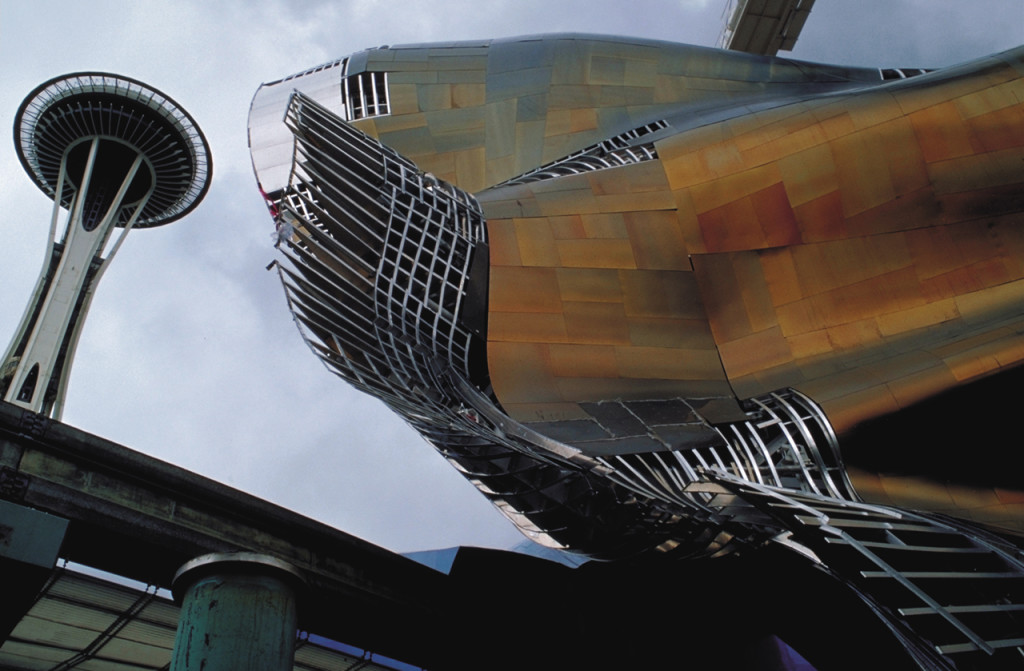
Steve Huey, PE
Principal
Steve received his Bachelor of Science in Architectural Engineering and his Bachelor of Environmental Design from the University of Kansas. He is a licensed Professional…
View Profile
Many of you know that in addition to our “regular” engineering we also work on building “skins” for lack of a better term, mostly in the form of rainscreens. These are mostly metal and are made from thin plates, which are bent and twisted and perforated beyond recognition. These systems require structural engineering in atypical terms.
As building engineers we are accustomed to working on floor plates, roofs and walls. These are all systems that are relatively thick with regards to their spans and have small deflections. Thin metal plates may have thicknesses (or “thinesses”) of 18 and 16 gauge and spans in excess of 30 inches while resisting 20 psf or greater wind force. For comparative purposes this is the equivalent of covering a 20 foot roof span with just ½ thick steel plate, no joists. Now before anyone gets too excited about the cost savings involved in using thin steel plates for roof structures consider that the deflections on these metal panels is in the range of L/100, translation: 2.4 inch deflections, they flutter in the wind and there is “oil canning” under temperature changes on your roof span. This is not a best case scenario for a floor, roof or wall system but it is perfectly acceptable behavior for thin decorative panels. The secret to these thin panels is that you must restrict their movement at the outer edges and support the compressive forces that occur around them in a ring. If those conditions are met then the plate can deflect to the point where there is no compression zone in the top half of the plate, it is in tension throughout the thickness of the material. Think of it as a web of tension elements as opposed to small side-by-side beams. At the point where the plate goes into pure tension the stress becomes very low, so the plate does not permanently change shape and it will come back to the original shape when the load is relieved.
That’s great, but what the hell does it mean to me? Well, here’s the thing. Many of the performance specifications for wall panel systems are written using a modified version of the performance requirements for glazed curtainwalls. This would include deflections being held to L/175 at any point and much of the criteria are based upon a one way spanning system. The requirements for a glass wall are, or should be different than that of a metal rainscreen system. The glazing needs to be air and watertight whereas the rainscreens do not, there is almost always a membrane behind the panel and the joints are expected to leak. The glazing systems are supported by receiver channels that hold them in place but do not restrain them in tension the way a wall panel does. So a panel of glass can eventually deflect out of the restrains at the ends whereas the metal panel is held in place by fasteners on all sides. Because of this the primary criteria for rainscreen panel performance should be whether or not the panel becomes disengaged from the building in a windstorm (or earthquake) and secondly whether it has a permanent set. This “set” would mean that the metal material has yielded. Deflections at the highest levels of wind force are really superfluous with regards to panel performance as long as the panels do not disengage from the building and they aren’t visibly and permanently bent.
The performance of the panels can be specified to be proven by either engineering calculations or by testing. The calculations of the theoretical behavior of thin plates is beyond the realm of this blog (and most people’s realm of interest) but it is a relatively simple calculation using graphs devised years ago in the development of naval ship hulls and is not part of the normal curriculum of most engineers and outside of the scope of their everyday practice. And it is sometimes referred to as “wall panel voodoo”. That is where testing is helpful, you can prove performance by loading the panels and demonstrate the behavior as loads are applied. Performance under specified criteria is recorded and actual behavior is proven. There is also the most special of all types of testing, “Ozark Engineering Testing”. On a recent project we had a series of 3/16 inch perforated aluminum plates spanning 36 inches and they had to resist about 50 psf of hurricane grade wind force. We provided calculations to show the performance and behavior but it takes some engineering fancy footwork to correct for the perforations and an understanding of thin plate behavior. We were convinced with the results but the Owner’s reviewing consultant was not convinced and frankly did not really want to understand how we were predicting the behavior of the plates. They insisted the project should have stiffeners added and the plate thickness doubled. This is where Ozarks Engineering Testing can come into play in your specifications. We took the visual mockup of the plate elements and placed two fully growed engineers on top of the plate, whereby they proceeded to jump up and down for several minutes. We are talking nearly 400 pounds of prime Missouri yahoo punishing a thin, highly perforated plate that is spanning 36 inches. At the end of the dance the plate was clearly nonplussed by this activity and went on about the business of being a sunscreen without any adverse side effects.
Owner views video of testing…..panels approved.
I think I am out of time here and I notice I have not yet gotten to the subject of “structural pookie”. This will be a subject for another day then; class dismissed.
I am in the engineering business myself and rely quite bit on Pookie. I’m also an old school working stress design kind of guy. I’m getting flack from a younger plan check person who similar to your owner’s consultant, has difficulty buying into my thin panel trampoline design. Is there anything actually published that would support the high deflections, etc. I have tired to resolve the edge stresses in a manner similar to a PT design but end up with some pretty high edge loads that punish the support and not the panel. I really got a lot stress relieved as I laughed my way through your article. Thanks,